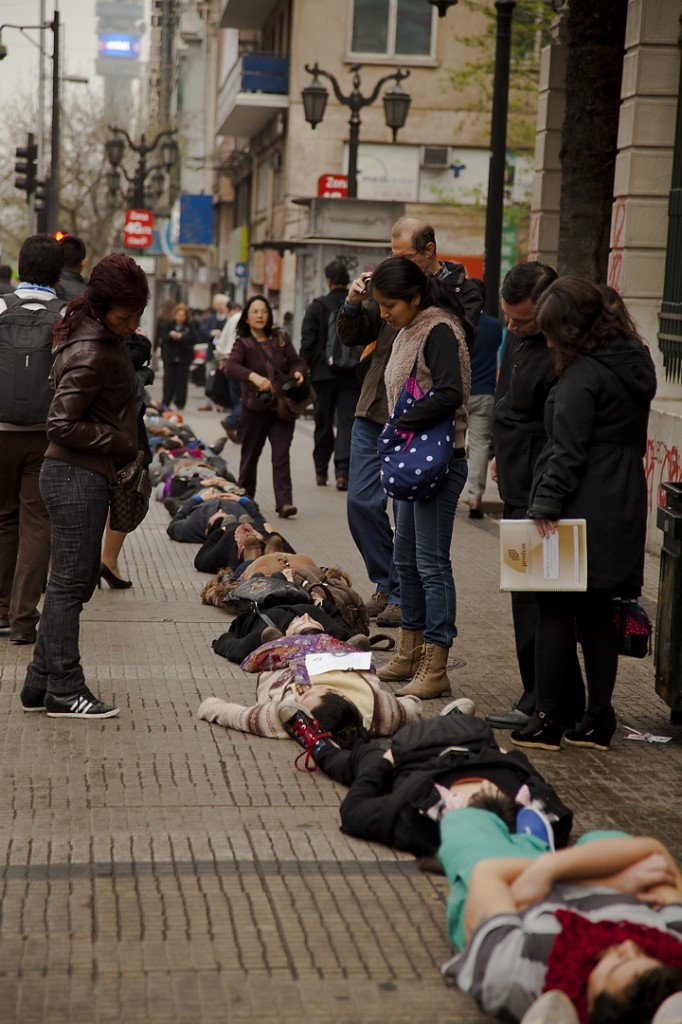
10 December 2013. The streets of Santiago in Chile are crowded, as they are every day. Only some police detachments distributed along the streets are evidence that this is not a usual Tuesday. You can breathe the tension in the city. It’s just one day before the fortieth anniversary of the state coup in Chile that occurred on 11 September 1973. The government and police forces are alert to possible demonstrations or protests. At 8:49 a.m., twelve hundred people interrupt their walk and lie down on the streets, creating a two-kilometer line running through the main street of the city from Palacio de La Moneda (the government building that was bombed by military forces during the state coup) to Plaza Italia (one of the main squares in the city). People lie down for eleven minutes, evoking “the 11th,” as Chileans typically refer to the date of the coup. Present bodies (or should we say a present collective assembled body) conjure the missing bodies of the twelve hundred detenidos desaparecidos during the dictatorship in Chile. Hundreds of bodies mobilize to expose what Chilean society insists on forgetting. The city stops for a minute. Police forces are perplexed; they don’t know how to proceed. The line is too long—there are too many prone bodies. People don’t know what is happening. Silence. At 9:00 a.m., the hundreds of people rise and continue on their way through the city. This performance is called #quererNOver, and I’m its “author.”1
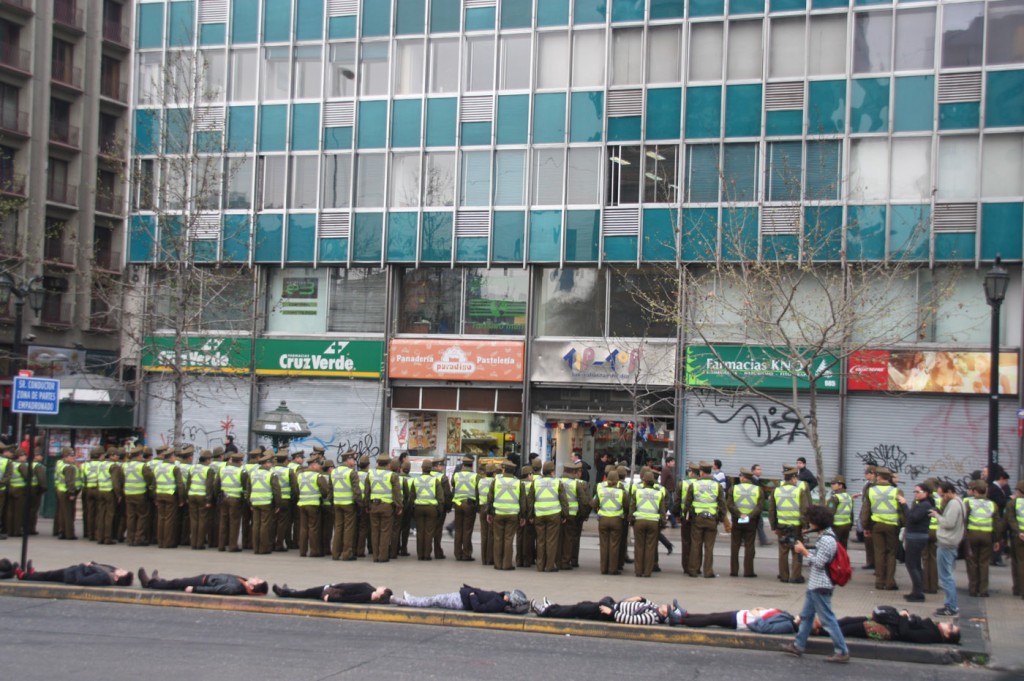
In what follows I attempt to draw preliminary links between #quererNOver and the notions of trauma, memory, and vulnerability. I named this performance #quererNOver since it seemed to me that it could somehow mirror the attitude of Chileans regarding the desaparecidos: forty years later, some people stop and observe the performance, trying to understand what this is about (as many people still battle to establish the meaning of the missing), whereas others decide to continue on their way, refusing to see.2
During September 2013 there was a saturation of images of and discourses on the dictatorship. The politics of memory raised in the fortieth anniversary of the state coup in Chile was profoundly tricky and perverse. Chilean society was tempted to think that some kind of disclosure was occurring after forty years. To my view, this was just an illusion. The sudden explosion of memorial gestures was actually creating a sort of fog effect to heighten the idea that everything that happened was already the past. These images and discourses promoted the idea of a new Chile that could look backward to a terrible but concluded and closed past. While open-access television almost obsessively broadcasted documentaries, soap operas, and reportages about the dictatorship, many politicians tried to advance the idea that after forty years Chilean society was ready to move forward. The polemical (but necessary) gesture of President Sebastián Piñera’s decision to close Penal Cordillera (an absurd prison with a spa-like infrastructure [it included individual cottages and tennis courts, among other luxurious privileges] for those condemned for violations of human rights) contributed to the illusion of closure. This narrative raised the fortieth anniversary as a milestone that could change the way we thought and confronted our past.
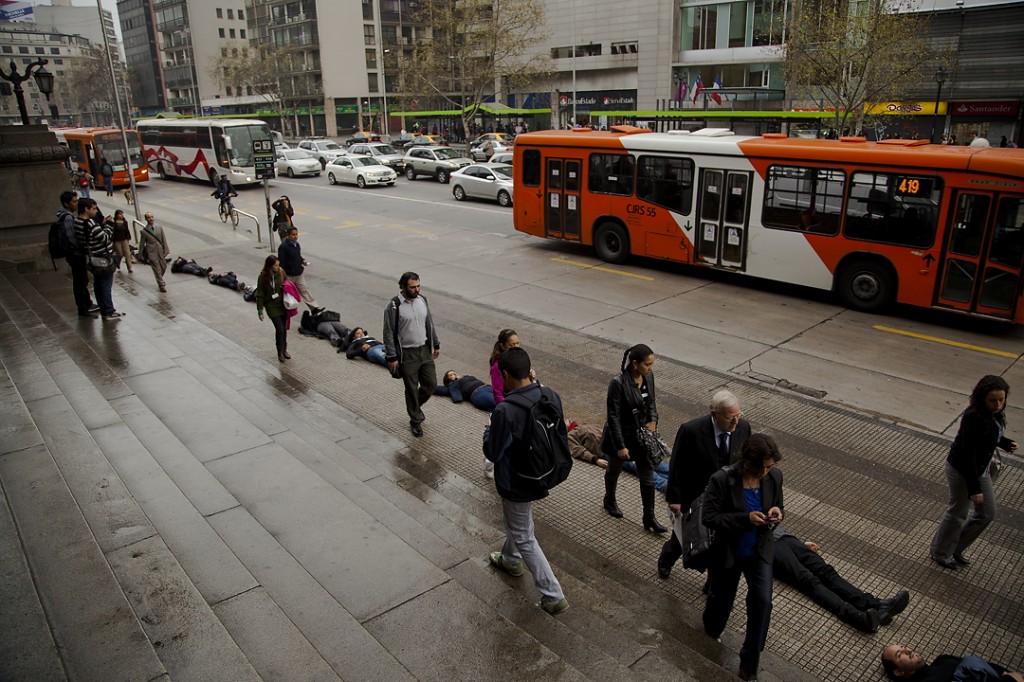
To my view, this explosion of memorializing gestures responded to a sort of compulsion of repetition typical of trauma. As Cathy Caruth describes, the traumatized “carry an impossible history within them or they become themselves the symptom of a history that they cannot entirely process” (108). All the images, TV programs, and political discourses were other ways of iterating trauma, symptoms of an “impossible history.” This saturation didn’t contribute to reparation but remained in a reiterative loop where we all could see what happened but were unable to learn about our past. In Chile, this loop is exacerbated by the lack of justice that impedes any sort of closure.3
Few people in the media spoke about the fact that we still don’t know the whereabouts of twelve hundred Chileans. Some right-wing politicians and ex-collaborators with the regime took the commemoration as an opportunity to insist that the desaparecidos were products of a few radical military forces that acted on their own initiative. Many generals have sworn during these years that they were not aware of the violations of human rights at the time—inconceivable, considering the hierarchical structure of the armed forces. This unacceptable minimization and cover-up motivated me to create and promote #quererNOver as a way of contesting denial. A two-kilometer line of bodies displayed in the city intended to challenge the narrative of desaparecidos as a marginal effect, to give evidence that the missing were the result of a clear state policy. The name of the performance is provocative: if you claim you didn’t know about the desaparecidos forty years ago, then you just didn’t want to see.
#quererNOver intended to advance a way to overtake the vulnerability produced by the community’s diminished sense of agency since the state terror, a vulnerability that persists to some degree in our society. For eleven minutes, bodies assembled to remark, remember, and resist these echoes of the regime. For eleven minutes, a new body arose, one that allowed a new sense of collective agency: we can do something about our past; we can construct (other) memories together.
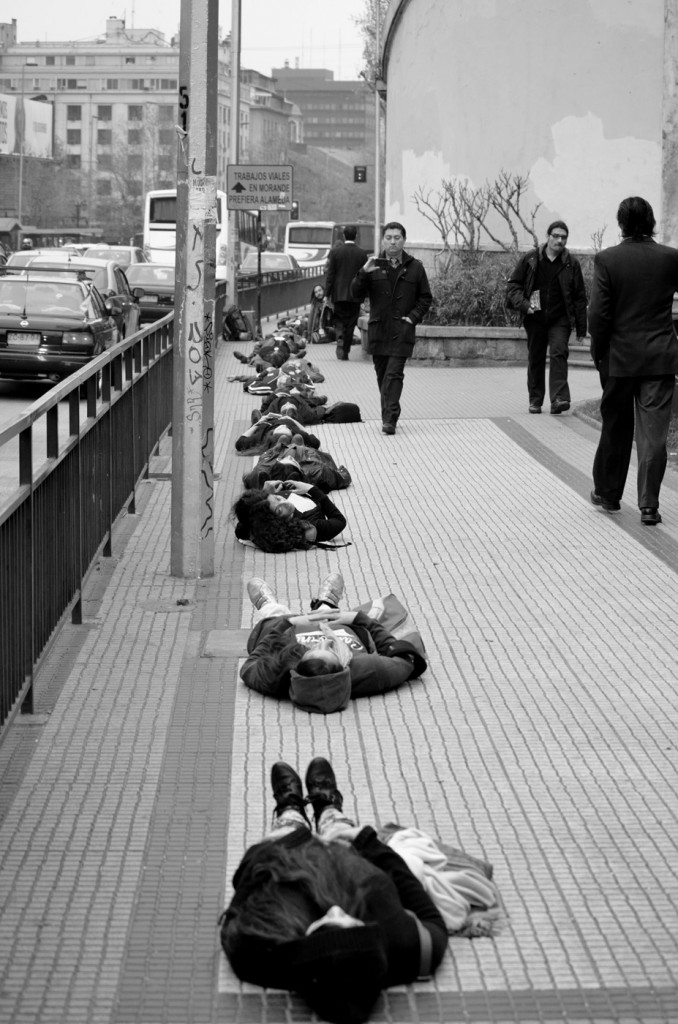
The line was made up of unknown people that united under a political scope. This assembled body somehow dismantled vulnerability, understood as the isolation of a singular body. #quererNOver reclaimed that condition of dependency of the body to other bodies. As Judith Butler points out, “despite its clear boundaries, or perhaps precisely by virtue of those very boundaries, the body is defined by the relations that makes its own life and action possible.” In the context of the performance, the dependency on other bodies offers the possibility of political agency and the empowerment of individuals.
#quererNOver also restituted the street as a political and aesthetic arena. One of Pinochet’s first bandos (“proclamations”) prohibited gatherings of more than three people in public spaces. Thus this collective action not only occupied the current street but also symbolically occupied the street that forty years ago was out of bounds. Even if we’ve witnessed many massive demonstrations in Chile in recent years (e.g., the Revolución de los Pinguinos in 2006 and the enormous student protests in 2011), the echo of the dictatorship is still somehow present. While I was organizing #quererNOver, many people asked me whether we had permission to be on the streets. Some didn’t participate since they were afraid of the police reaction. The official authorization was an issue I discussed with my collaborators. At last, I decided that we wouldn’t ask for permission. Many reasons supported this decision. First, I defended the political gesture to recuperate the right to occupy the streets. Second, I wanted the action to provoke a surprise effect and to be ephemeral. Since the action lasted only eleven minutes, the television channels and many journalists couldn’t arrive in time to tape or photograph it. This inability to capture the event produced a phantasmagoric presence that somehow mirrored the situation of detenidos desaparecidos who are “not-present”—that is, who are part of what I think of as the “no-presence,” a liminal state between presence and absence. Detenidos desaparecidos are not absent; to be absent, you have to be somewhere else. The crucial fact is that the missing bodies are nowhere, they have no place, a paradoxical condition that makes it hard to talk, write, stage, and represent them. As Diana Taylor points out in Disappearing Acts, thinking and representing the desaparecidos implies traps and complexities that require us to question, “[H]ow to think and write about these bodies? What do these invisible bodies mean? Who determines the meaning?” (147).
#quererNOver was an attempt to mirror this paradoxical condition: the action constructed a presence in the city that immediately disappeared. The performance intended to articulate the material presence of the here and now with the nonpresence of the desaparecidos. The twelve hundred bodies lying in the streets were not representing the missing; rather, they exemplified and communicated the nonpresence of the desaparecidos and the strategies that supported their oblivion.
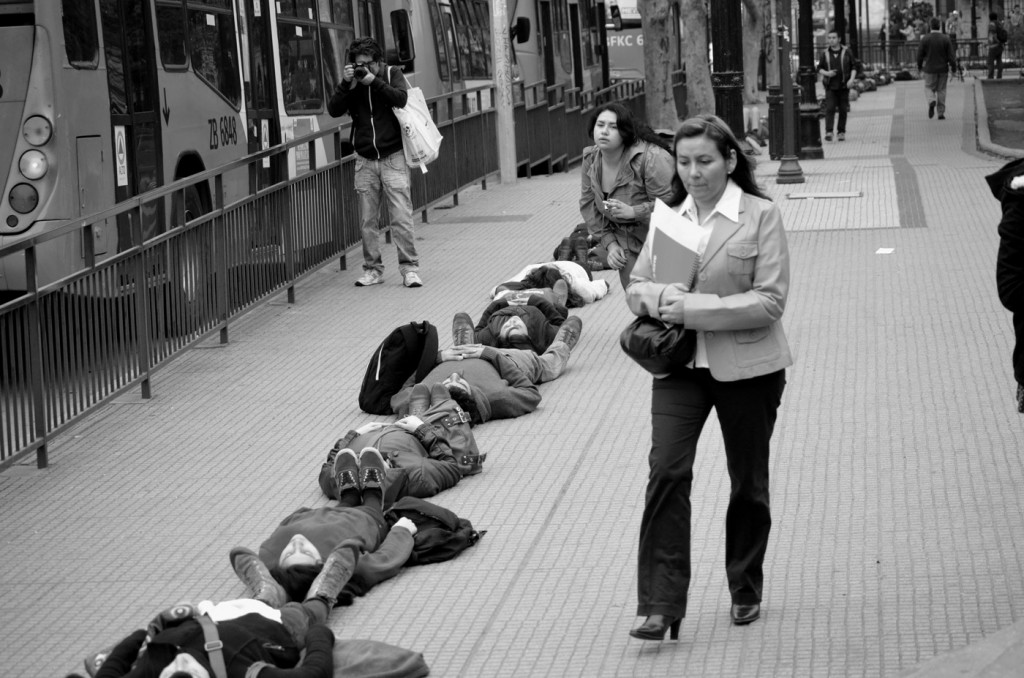
The performativity of #quererNOver allowed a disruption at many levels. It disrupted the material scenario of the city, which, as one participant said, “stopped for eleven minutes to remember.” Materially and symbolically a new city was created, one that could include the memory of a painful past. Something that called my attention that day was the opposition between the noise of the city and the silence of our action. People walking by could choose to continue in the city’s noise (and thus #quererNOver), to stop and observe, or even to stop and join the line. In any of these cases the line of persons lying down disrupted and dislocated the normal functioning of the city.
#quererNOver also disrupted the way in which the memory of the state coup was being produced at the moment. It stood up to the apparent closure and served to remind people and reinforce the idea that some injuries are still open, that justice has not been done, and that there are still hundreds of Chileans missing. It implicitly posed the questions, Can we still talk about reconciliation? What kind of reconciliation is possible?
The modality by which this disruption took place was performativity, which Butler defines as “a chiastic relation between body and language.” The efficacy of the action, its impact in Chile and overseas, is due, to my mind, to this alternative embodied way to remember and to resist hegemonic narratives. The twelve hundred bodies resisted the power of words that naturalized indifference and oblivion. #quererNOver was sustained by bodily performativity as an alternative to the verbal and visual disposition that predominated in the commemoration of the state coup, and this other way of remembering and commemorating resulted in an alternative politics of memory.
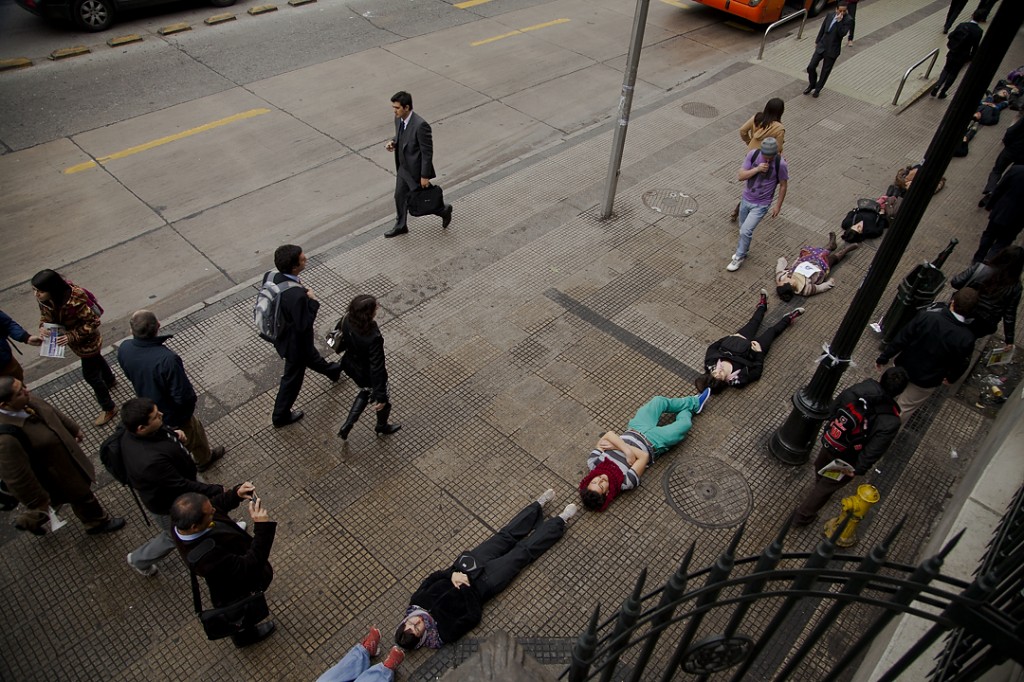
In addition, #quererNOver gave citizens the opportunity to manifest their resistance to the way the memorialization process was being carried out. Many participants declared after the action that they were willing to participate in the reconstruction of memory but didn’t know how. The fortieth anniversary reduced the space of participation to social media, where people could, in tweet-length reflections, make their opinions known. This outlet proved to be insufficient; people felt the need to participate more actively in the reconstruction of their own past. #quererNOver encountered the desire to participate in the memorialization process not only virtually but also corporeally. Participation functioned at various stages: beforehand, in collaborating on the project and recruiting participants; during, in the material action of lying down; and afterward, in the spreading of thousands of pictures and videos made by the participants that expanded the life of the performance. Participants were very heterogeneous in terms of age, gender, and origin, which means that the desire to participate transcended Chilean society. As the author of #quererNOver, I saw my most important contribution as that of interpreting this need and drive.
The bodily performance of #quererNOver allowed participants, to some extent, to surpass the vulnerability of a traumatic (present) past. The performance drew a scar in the city, one that is not always visible but that persists, haunting our present. That day, twelve hundred people resisted the narrative that intended to bury the bodies of the desaparecidos in a fictional past and stood up, or should we say lay down, to bring into presence the nonpresence of the missing bodies. #quererNOver resisted vulnerability and, by assembling and mobilizing bodies, empowered subjects to regain the possibility to construct an alternative memory of the past.
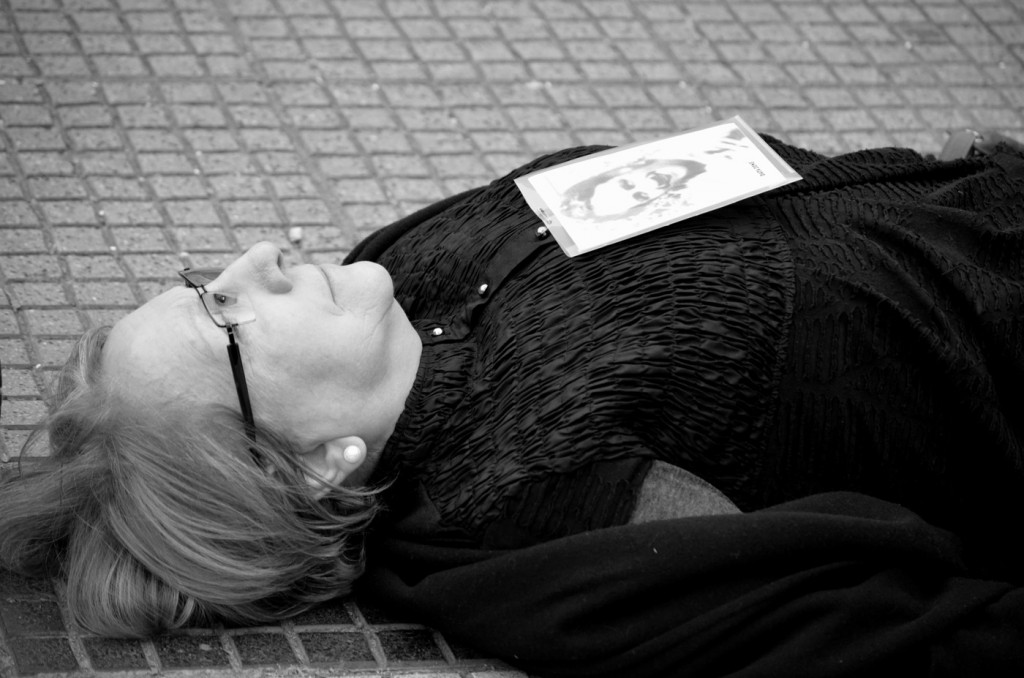
The gesture not only obliged society to remember but also allowed participants to connect with the terrifying experience of disappearance. As one of the participants wrote:
Lying in the cold pavement looking at the sky made me think about all those people, how they lived their last days and how they died. I never thought about that before. Feeling the indifference of some people in the streets who didn’t even stop to look at us, I was able to feel in my own body the painful crusade that the relatives of the missing have passed during the last forty years while pleading for some information that may reveal where the bodies of their beloved are. (my trans.)
Notes
- #quererNOver can be translated as “wanting not to see.” You can visit the performance blog (www.querernover.wordpress.com) or my Web site (www.mariajosecontreras.com) for more information. The problem of authorship is particularly relevant in this performance. Even if I had the original idea, the performance was constructed and produced by the participation and collaboration of many people. I would like to acknowledge my close collaborators, Andrea Pelegri, Pablo Dubott, and Ivan Smirnow; the social media ambassadors who helped spread the call; and of course everyone who participated that day.↩
- The denial of the violations of human rights during the dictatorship is strong in Chilean society, as many scholars have noted (see, e.g., Stern; Demaria; Nicholls). ↩
- According to a report from the Universidad Diego Portales, as of May 2012, just seventy-six ex-agents of Pinochet’s regime were condemned, and of those only sixty-eight were in prison (Informe). ↩
Works Cited
Butler, Judith. “Bodily Vulnerability, Coalitions, and Street Politics.” Digital file.
Caruth, Cathy. Unclaimed Experience: Trauma, Narrative, and Culture. Baltimore: John Hopkins UP, 1996. Print.
Demaria, Cristina. Semiotica e memoria. Analisi del post-conflitto. Roma: Carocci, 2006. Print.
Informe anual sobre derechos humanos en Chile: 2013. Centro de Derechos Humanos. Centro de Derechos Humanos, U Diego Portales, 2013. Web. 4 Apr. 2014.
Nicholls, Nancy. “Chile: Las paradojas de la memoria entre el boom y la negación.” Puentes 22 (2007): 34–39. Print.
Stern, Steve J. “De la memoria suelta a la memoria emblemática: Hacia el recordar y el olvidar como proceso histórico (Chile, 1973–1998).” Memoria para un nuevo siglo. Chile, miradas a la segunda mitad del sigo XX. Comp. Mario Garcés et al. Santiago: Lom, 2000. 11–33. Print.
Taylor, Diana. Disappearing Acts: Spectacles of Gender and Nationalism in Argentina’s “Dirty War.” Durham: Duke, 1997. Print.
Posted May 2014